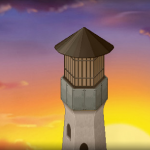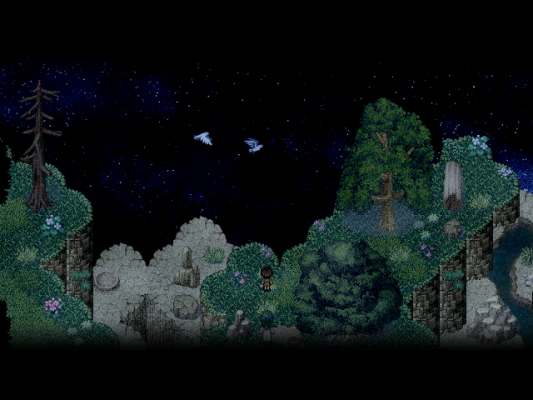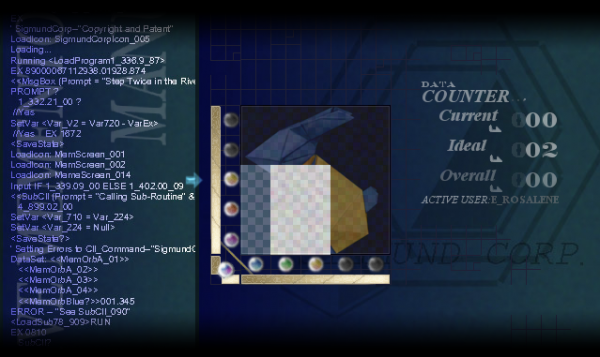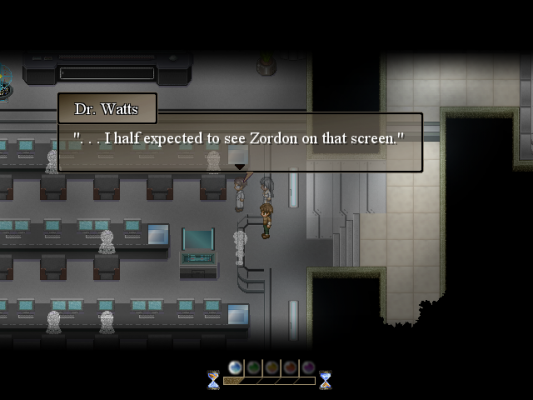
To The Moon review
Until now, I’ve never tried my hand at the massive library of highly-acclaimed indie games on Steam. And since I’m a hemisphere away from my game console, I finally have a reason to dig through that backlog of Steam games in between bouts of cultural immersion and stumbling home drunk from a Beijing night club at 1am.
So what is To the Moon?
To the Moon is an independent fantasy RPG released by Freebird Games in 2011. It is one of those simple, pixelated games that you see constantly on sale on Steam. It has a top-down 2D perspective à la Chrono Trigger or Golden Sun. But instead of turn-based combat and an epic story across the world to save all of time and space, To the Moon scales back the open-world environment that you might expect. In fact, there’s no combat, traveling, or new equipment or abilities. This game takes essential elements of 2D RPG’s and replaces them with an emotionally compelling look at a man’s life.
The Premise
The story opens on a cliffside mansion in an idyllic, lush coastal region. Two scientists with full lab coats and gear (Dr. Rosalene and Dr. Watts), sent from an unseen and unexplained corporation, enter the scene. They enter the home and find an old man (Johnny) on his deathbed. The doctor claims that Johnny has very little time left, and wishes to see Dr. Rosalene and Dr. Watts. In his final hours, Johnny wants one final wish granted, and these new doctors are trained and certified in the practice of granting wishes. What that means exactly is unclear for now. His single wish is vague but simple.
He wants to go to the moon.
Drop that title like it’s hot!
The two doctors hook Johnny up to a machine similar to something from Inception. Dr. Rosalene (a woman who takes her work very seriously but who still has a sense of humor) and Dr. Watts (a young, nerdy beginner with a penchant for screwing around) don special helmets and are able to access Johnny’s memories. The rest of the game takes place during various stages of Johnny’s life. Rosalene and Watts begin from Johnny’s most recent memories and begin to work their way backwards. As the doctor’s travel further and further into Johnny’s youth, they see the sort of life that the old man lived. We see his adulthood and uncover this loving and seriously believable relationship between Johnny and his malady-afflicted wife. We see in reverse what events led up to his marriage, and his emotional maturity as a person. Toward, the end we are shown some dramatic and tense moments in his childhood.
All the while, Rosalene and Watts are able to view these memories like invisible ghosts. No one else can see or hear them unless they want to interact with the memories. For you see, that is the entire point of traveling into Johnny’s memories. The two doctors have to activate mementos in Johnny’s brain (ad hoc plot devices cleverly strung along) to find their way back to his childhood. Once there, they will lay down certain influences that will grant Johnny’s wish of going to the moon. By manipulating memories, these scientists can alter this old man’s mind and make him believe that he went to the moon. He won’t have gone there, of course. He’ll be lying in a bed living his final moments while his brain is living out his greatest dream.
How exactly this all goes down would be some serious spoilers, though, so you’ll have to play the game to see how this wish is finally manifested, and what goes horribly wrong in the process.
Game Play
Much of the game is a simple point-and-click adventure around the mansion and the small portions of Johnny’s memories. Using a mouse is much easier than the keyboard, but otherwise it controls fine. All you do is enter new rooms, analyze bits of the environment, and find necessary items to move the plot along and shift between memories.
On each memory, there is one item that acts as a memento between years. These are very mundane objects like toys, clocks, and backpacks. Some mementos also serve a dual purpose as plot devices that mark stages of Johnny’s life. Within each memory, you must explore the small stage and interact with five moments in the man’s life. Sometimes you just have to touch an item that was memorable to him, or interact in a dialogue that was a significant moment for Johnny. Each moment sports you a colored jewel, five of which you must gather to activate the memento and advance.
To activate the memento, the game presents you with a small puzzle. These puzzles are very simple and not difficult in the least. You have to flip tiles to reveal a full picture of the memento that you’re activating. It’s nice to add a puzzle element into the game, but it really poses no challenge.
A typical puzzle in To The Moon. Flip each row or column by clicking on the orbs to reveal a clear image.
Presentation
For an indie game that takes its influence from SNES and GBA graphics, To the Moon stays pretty faithful to the art style. Top-down environments are small but very detailed. They are colorful and vibrant not in a Viva Pinata way, but in a way that feels real despite being the world being entirely flat. Backgrounds are lovely, and the small hallways and streets of Johnny’s past lack depth in visuals while still feeling important to the story.
The soundtrack consists of faint piano melodies that add to the serious drama rolling out before you. The music truly completes the serious love story and the sad tales of Johnny’s youth in a way that couldn’t be done justice otherwise.
Sense of Humor
The writers of To the Moon have a very interesting sense of humor. Seeing as a lot of this story is pretty serious and will tug at your heart strings, the writers put in plenty of comedic relief to diffuse the constant drama. Where Seth McFarlane likes to insert references to obscure 80’s pop culture, To the Moon makes references to lots of 90’s television, Doctor Who, and old RPGs. It’s humor by allusion. Allusion attempting to be jokes. They end up not really being funny, just serving as a reminder that Freebird Games are dorks, too. They writers don’t want you to forget how genre-savvy they are.
OH! And Animorphs. Animorphs references everywhere. So much so that the old book series from the 90’s gets pulled in to the plot somehow.
The only thing cooler than bow ties is Power Rangers references.
Conclusion
To the Moon took me about three and a half hours to complete. It is a short game, for sure, but don’t doubt that you’ll get a full experience. The game play is very basic, as is the art style and way of telling its story. To the Moon takes a minimalist approach to its presentation, but it provides enough character building and engaging story to make up for it tenfold. Each character, even the ones that we only see briefly, feels strangely real for just being little pixel people.
By the end, I really felt for Johnny and his wife in a way that many other stories can’t manage. It’s really sort of remarkable that so much humanity is packed into these tiny sprites. That’s a sign of darn good story telling. I felt more connected to these characters than to some live action actors I’ve watched on screen.
To the Moon isn’t breaking any bounds. All it is doing is telling a creative, new story about one single person’s life. Freebird wanted to take a style of game that we all know and do something unique and special. If you are into cool, artistic indie games, then I’d really recommend this one. If you just like emotionally-persuasive pieces of fiction that try telling a deep story with well-built characters, then you’ll definitely dig To the Moon. It’s a sweet and heart-warming tale that you’d have to inhuman not to enjoy.
4/5
A Great, Charming Indie Game
What do you think of To The Moon? Shoot us a comment after by visiting our forums!



0 Comments
This post has been left all alone with no comments. Don't leave it lonesome - give it some company with a comment.